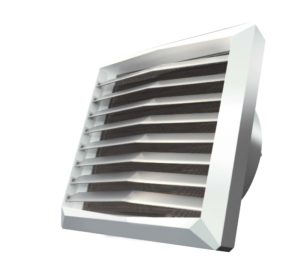Beijing’s new USD 12 billion airport, slated to be the world’s largest, will see a departure from China’s reputation of building stuffy and poorly ventilated aviation hubs, claims VTS Group, which has supplied its air curtain and air heater solutions to the facility
 Located less than 50 kilometres south of the capital of China, Beijing Daxing Airport is slated to become the world’s biggest airport and the most progressive and modern transportation centre. According to officials in China, the airport, being built at a cost of around USD 12 billion, will be a great model of futuristic infrastructure, filled with the most advanced and highest quality technology.
Located less than 50 kilometres south of the capital of China, Beijing Daxing Airport is slated to become the world’s biggest airport and the most progressive and modern transportation centre. According to officials in China, the airport, being built at a cost of around USD 12 billion, will be a great model of futuristic infrastructure, filled with the most advanced and highest quality technology.
The new airport will act as a second international airport for Beijing, to relieve the pressure on Beijing’s Capital International Airport, which is straining under a heavy load.
With the opening planned for September 30, 2019, the Beijing Daxing Airport will have a capacity to handle 45 million passengers annually by 2021, and 72 million by 2025.
 MODERN DESIGN AND TECHNOLOGY
MODERN DESIGN AND TECHNOLOGY
In contrast to already functioning airports, the Daxing airport is shaped like a spreading six-petalled flower, where the central hub will be used for passenger processing, ticketing and security. Five of the petals will lead to gates, with the sixth hosting administrative offices. By using distributed zones of operation, the airport is set up in such a manner that passengers will arrive at the carousel in less than 13 minutes after their flight lands at the airport.
Given its futuristic design, the new airport is obligated to deliver the highest quality and the most developed of technologies. For example, the airport will feature robots at automated security checkpoint, or as patrol inspectors. The robot inspector will guarantee the airport’s higher requirements for security of power supply. The inspector will assist the system in carrying out inspections – at considerably improved speeds. Currently, the inspection process lasts 1-2 minutes, whereas it will last 10-30 seconds in the new regime, with data recording and analysis occurring simultaneously. The robot inspector is expected to improve the intelligent management level of the airport’s substations.
AND WHAT ABOUT THE VENTILATION?
 Airports in China have always been known for being stuffy and poorly ventilated. Even when a new, expensive and modern-looking airport opened in the country, passengers had the feeling that someone had forgotten to design or simply switch on the air conditioning. In the case of Daxing, though, the ventilation will be of the highest standards for aviation centres in Asia. The ventilation systems in the air conditioning units will benefit from the support of a very efficient set of air heaters and air curtains with the objective of assuring comfort and pleasure.
Airports in China have always been known for being stuffy and poorly ventilated. Even when a new, expensive and modern-looking airport opened in the country, passengers had the feeling that someone had forgotten to design or simply switch on the air conditioning. In the case of Daxing, though, the ventilation will be of the highest standards for aviation centres in Asia. The ventilation systems in the air conditioning units will benefit from the support of a very efficient set of air heaters and air curtains with the objective of assuring comfort and pleasure.
Faced with unpredictable and quickly changing weather patterns, caused by the high amplitude of temperature and Beijing’s infamous smog, the designers of Daxing decided to opt for air curtains to ensure a comfortable environment in the complex. By using air stream air curtains, their target was to prevent insects and impure air mixing with the inside air of the premises, keeping the chilled air inside at its utmost purity. They reached out to VTS Group for its WING air curtains. The result: 298 sets of WING air curtains, which are so named because they look like the wings of an aircraft, to protect the facility.
THE VOLCANO EFFECT
 In addition to its WING air curtains, VTS supplied its VOLCANO air heaters to control the temperature parameters inside the buildings, as a counter to the fast and dynamic weather changes in the Daxing airport area. The heating units, numbering 162, once fully operational, will control the inside temperature even in the middle of severe winters, at a low cost.
In addition to its WING air curtains, VTS supplied its VOLCANO air heaters to control the temperature parameters inside the buildings, as a counter to the fast and dynamic weather changes in the Daxing airport area. The heating units, numbering 162, once fully operational, will control the inside temperature even in the middle of severe winters, at a low cost.
The WING and VOLCANO are equipped with electronically commutated (EC) motors, which allow for the possibility of reducing energy costs – a significant concern in the case of extensive buildings, like airports, where devices are expected to work 24 hours a day without any interruptions all year through. Introduced in 2017, the energy-saving motors reportedly have the ability to lower power consumption costs by even 50%.
BMS COMPATIBILITY
While the presence of EC motors in the WING and VOLCANO is being regarded as a major attribute, an equally significant one is their ability to cooperate with a Building Management System (BMS) regime. This would mean that functions, like Door Optimum and Calendar programming, can be set up for all ventilation devices from one place and would allow operators to have an easy and quick view of impact on conditions and parameters prevailing at any given moment in the facility.
Copyright © 2006-2025 - CPI Industry. All rights reserved.